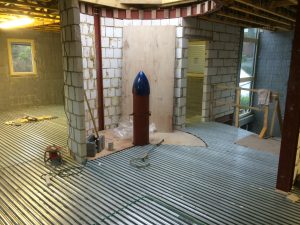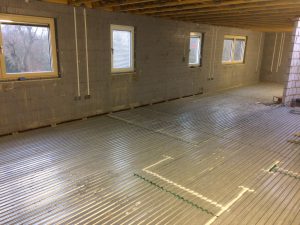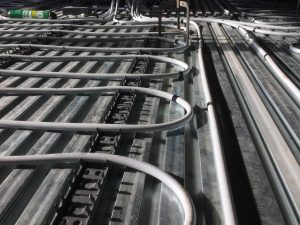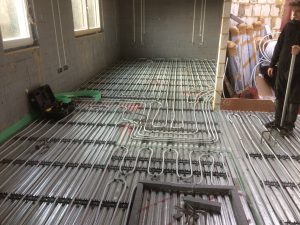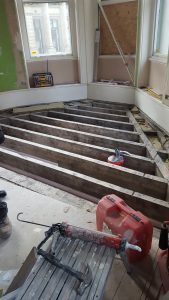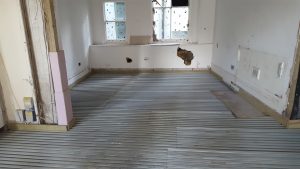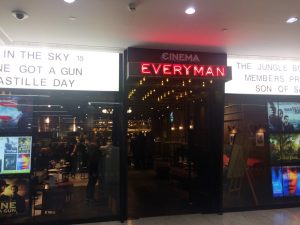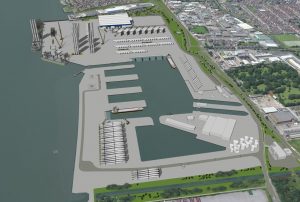The Blue House with Durisol ICF Blocks
One of the more interesting aspects of working with self-build projects is the varied and, at times, very different approaches that are taken when it comes to the design of a new property. This property is no exception.
Built on a self-build development site at Graven Hill in Bicester, where every property is different, it utilises a number of different design styles and is constructed from an ICF system called Durisol Blocks.
See this house and the one next door that both used the Lewis Deck system on Grand Designs: The Street
Durisol is the original ICF units. They were introduced to the UK in 2005 having been successfully used for build projects across mainland Europe for over 70 years.
Their wall form units are quick and easy to construct. The pre-insulated interlocking ICF wall form units are dry stacked together to form the walls. The wall form units are then in-filled with concrete to form a monolithic structural walling system. Unlike other ICF wall form units, there is no need to prop the walls during construction as the weight of the blocks holds them in place. All of their products are manufactured in South Wales from recycled cement-bonded wood fibre material.
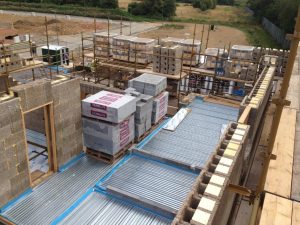
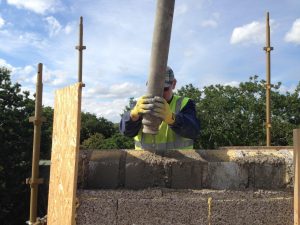
One of the benefits from using the Durisol system is that you can use the same concrete that is used to fill the wall blocks as the screed for the Lewis Deck. As with all other concrete/ screeds it only needs to be 50mm thick without underfloor heating pipes or 52mm with underfloor heating pipes. This could potentially help with the speed of build as it is possible to do two jobs at once!
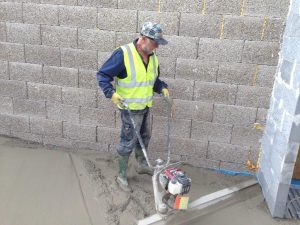
Durisol Blocks are extremely easy to install and you can learn how to install them yourself. Durisol hold regular training courses throughout the year. The courses are designed to show you how to build with Durisol and answer any queries. If you’re thinking of building with Durisol they provide the perfect opportunity to find out more about their product.
These training courses are often at the National Self-Build and Renovation Centre in Swindon where we also have a permanent stand and where we attend every exhibition that the centre puts.
If you are thinking about building your own property using this type of system with Lewis Deck means you can actually build it yourself. Well, maybe not all of it!!
Traditionally Built House, Rugby
One of the questions we constantly get asked at trade shows and over the phone is “Can we use Lewis Deck on traditional build or does it have to be on a certain type of build method?”
The answer is it doesn’t matter. The only design element that we look for is what is the floor support system underneath the deck? As long as there is a timber joist, a steel beam or even a concrete beam to support the Lewis Deck the system will work.
This was the case with this project. This self build project was to be traditionally built using concrete blocks with render and timber cladding providing the exterior look of the building. The main concern for the upper floor was for it to be solid, able to reduce the sound through the floor and also, due to the type of construction, it was needed to be a safe working deck that was able to hold the weight of the concrete blocks that were needed to build the upper floor of the house.
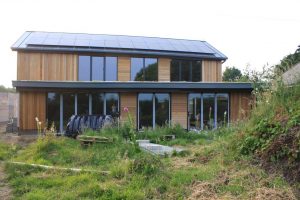
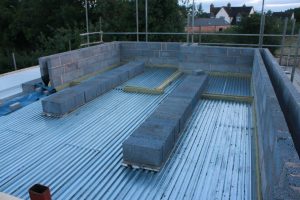
The Lewis Deck was exposed to the elements on this project for over 3 months while the 1st floor was build and before the roof was installed making the building watertight. In this time the deck was able to withstand the rigours of the traditional build process of blocks & mortar tubs being stored on it, materials being dropped on it, heavy foot traffic and also the English weather. As you can see from the photo above the Lewis Deck has been protected by laying the blocks on a scaffold board. This is recommended so that the decks dovetails aren’t damaged during this phase of the work.
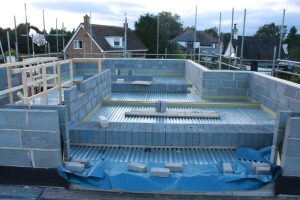
Once the building was watertight the underfloor heating pipes and screed were installed without issue, as you can see from the photographs opposite.
When it comes to this element of work all we recommend is that the deck is checked and any heavy debris is removed from the dovetails and if needed running a vacuum cleaner over it, to remove heavy dust/ dirt, prior to the screed being laid.
Lewis Deck to New ICF Property
One of the best situations we find ourselves in at CDI is meeting people at a trade show and, after getting the initial “I’ve never seen this product before” comment, having the discussion about Lewis Deck that gets them over a major problem that they were having with their project.
That was the case at Ecobuild last year, when the last conversation of the whole exhibition, just as we were about to start taking the stand down, began with that phrase we get said to us so often. The gentleman in question stopped at our stand just as he was about to walk out of the exhibition when he saw our Lewis Deck model with underfloor heating pipes. The subsequent 10 minute conversation with us went through the whole system and at the end of the conversation we heard another one of the comments we get at the end of conversations, “this has just made coming here worthwhile! I’ve been looking for a way to get underfloor heating upstairs but I didn’t want to use a timber inlay system”.
Within a week we had a further conversation on the phone and had received a copy of the 1st floor layout and joist design drawing. From this we had a quotation sent out the following day along with supporting information that was requested.
Things went quiet for 6 months as the design was finalised and then in November 2017 we had received the order and the Deck and resilient strips were delivered in the last week of the month. The deck was installed without an issue and it took just over a day to lay, including some awkward cuts around a curved stairwell.
At the beginning of 2018 we decided to add a clip rail system to our range of ancillary items that we stock. Fortunately for us, and for this project, the timings were great. We arranged delivery and had them on site for the beginning of February. As this was our first project using these rails we were keen on getting comments back on their performance. These were:
“General feeling was they went down very well and although it takes a bit more time to prepare, it does lay quicker than just using p-clips. Having said this the p-clips are a must for the turn rounds and go in easily with the tech screws. The clip rail also screwed down simply and quickly using the self drill screws and, if some pre thought is applied as it goes down, some of the screws help to double up on screwing down the Lewis deck joins”.
Queen Street Apartments, Newcastle
The conversion of the 1st floor of the Grade II listed Princes Building in Newcastle’s Quay side area into 10 apartments was carried out by local main contractors T. Manners & Sons Ltd. The building, which was designed by William Parnel who was responsible for some of the best architecture in the City, was built back in 1863 and as such posed some interesting problems when it came to bringing the building up to current standards.
In particular, the issue of acoustics from the ground floor commercial area, to the new apartment level was a concern. Because of this Lewis Deck specified by the architect due to the very high performance figures it achieves, especially when used in combination with our Sylomer TSS resilient strips.
The combination of the Lewis Deck, a minimum 50mm screed and the Sylomer meant that hitting the necessary dB figures for British Regs was taken care of and it also allowed these “luxury” apartments to have a solid “concrete” floor rather than a timber floor that would become problematic over time.
The shape of the building gave some additional issues with the laying of a floor. As Lewis Deck is made from 0.5mm gauge steel it is easy to cut allowing the deck to be laid into these shapes quite easily.
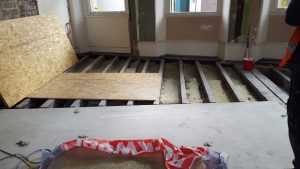
As this building is from the mid 19th Century the floor joists were positioned at very irregular centres. The Lewis Deck, as the sheets were 2500mm in length, were able to deal with is quite easily and they can be used as a safe working deck prior to the screed being laid. The existing joists were also found to be somewhat out of level as well. This posed a problem on site as the floor was to be screeded. This issue was overcome after an onsite discussion highlighting that Lewis Deck spreads the loads imposed on it across the whole floor as oppose to creating point loads as other systems do. This allowed the site team to level up the floor by thickening the concrete screed as needed.
Kingswood Warren Mansion House conversion
The conversion of the Listed Mansion House on the Kingswood Manor estate in Surrey required very high performing acoustic floors for these very high quality apartments, the floors also needed to cope with the use of large format tiles, including marble without the danger of any deflection and cracking. This was achieved using the Lewis Deck system for all of the floors, but included the wet-room bath rooms and the incorporation of under floor heating throughout.

The Lewis Deck with resilient strips underneath was installed over the existing timber floor to provide very high levels of both airborne and impact sound protection to the apartments below, this includes the low frequency noise associated with footfall, etc and can be particularly troublesome with light weight floor constructions and hard floor coverings.
Underfloor heating pipes were secured to the top of the Lewis Deck with clip-rails and P-clips before the installation of the free-flowing liquid screed.
Insworke Mill Quay
Insworke Tidal Mill was originally built around the 1590’s and survived as a working Mill until just before the First World War.
It then had a chequered life as various storage and manufacturing uses until it fell into total disrepair. It went under a major refurbishment and rebuild programme in 2011 to find a new life as a commercial property to the ground floor and residential to the upper floor.
The client turned to a Lewis Deck / screed solution when looking for solve the problem of acoustic and fire separating floors that would allow the new timber beams to be left exposed from beneath to replicate the original beams. On the ground floor Lewis was used to in a similar way to create a warm floor above the voided cellar areas. Lewis Deck on resilient strips was placed on to the new beams with a flanking strip around the perimeter. Underfloor heating was then fixed to the Lewis Deck before the screed was laid giving an overall depth of deck, underfloor heating pipes and screed of just 52mm.
The system is often used in this way in listed buildings such as this to preserve the existing structure and upgrade the performance of the floor. As the floor is laid as a floating structure, that is, without connecting it to the existing timber, it doesn’t damage it and if required, could be removed in the future to bring the floor back to its original state.
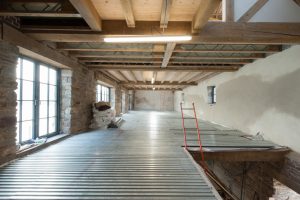
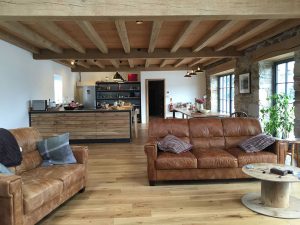
Lewis Deck to Everyman Cinema, Canary Wharf
The Everyman Cinema in Canary Wharf, London is one of a number of cinemas around the UK that has used Lewis Deck as the flooring system due to the amazing acoustic results that you get from it.
When used in conjunction with a 50mm screed and Sylomer resilient acoustic strips with 100mm mineral wool insulation between the floor joists you get airborne sound results of 45db and impact sound results of 62db which is 17db and 15db respectively better than current British Regulations.
Hody to Alexandra Dock
The scheme includes infilling one third of Alexandra Dock with 780,000 m3 of material and reclaiming 7.5 ha of the river to create a new 650m quay wall, which can accommodate three offshore wind installation vessels.
Construction will also involve dredging a new berth pocket, completion of earthworks and surfacing, building internal access roads and service networks, construction of a new Roll-on / Roll-off ramp and demolition of some existing buildings.
FastSlab GF System to Ingerthorpe Grange
We were initially contacted by the main contractors engineer regarding the use of Lewis Deck to the ground floor of Ingerthorpe Grange. The building is a grade 2 listed property just outside of Ripon, North Yorkshire.
The project was to completely renovate the internal areas of the house and bring it up to current standards. They were looking for an efficient and solid system that would allow the use of UFH on the ground floor and remove the potential for squeaky timber floors as the original ground floor timber joist and floor were damaged beyond repair.
During the rip out phase of the works it was found that the timber floor joists over the basement areas were rotten and needed to be replaced. After a discussion with us regarding the problem we suggested using the FastSlab ground floor system as its lightweight and quick install benefits would allow them to get back on programme and also allow the use of the Lewis Deck and therefore keeping the design changes to a minimum.
Op-Deck to The Curly House
Initial project meetings first started in early 2008, the clients owned a small cottage on the site which had been extended several times during the 80’s and had permission to make further adaptations. The mixture of building standards meant that their home was extremely drafty and very energy inefficient. The site itself is particularly exposed. The design which achieved planning permission was a crescent form which steps and slides into the slopes on the site. The crescent formation is in direct response to solar orientation.
The brief was to design a building which would accommodate the family for many years into the future, the planned occupancy would be for 5 adults. Additionally, the home will be used for large family occasions. A requirement was set for a minimum 16 seated spaces to be available for dining during these family occasions.
Op-Deck was added into the scheme very early into the design process as the way of creating the highly insulated structural floor as the house was being designed under Passivhaus standards. The overall U-value of the property is 0.1w/m2K as standard. The system was installed on the lower and ground floors and also the roof.

